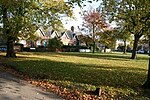South Wilford
Former civil parishes in NottinghamshireNottinghamshire geography stubs
South Wilford was a civil parish in Nottinghamshire from 1894 to 1935. It was formed under the Local Government Act 1894 from the parts of the parishes of Wilford and Lenton which were not part of the county borough of Nottingham. It formed part of the Basford Rural District. In 1935, under a County Review Order, the parish became part of the West Bridgford urban district. The part of the parish west of the railway line was added to the city of Nottingham in 1952.
Excerpt from the Wikipedia article South Wilford (License: CC BY-SA 3.0, Authors).South Wilford
Manor House Close, Nottingham Wilford
Geographical coordinates (GPS) Address Nearby Places Show on map
Geographical coordinates (GPS)
| Latitude | Longitude |
|---|---|
| N 52.933 ° | E -1.159 ° |
Address
Manor House Close 2
NG11 7BR Nottingham, Wilford
England, United Kingdom
Open on Google Maps









